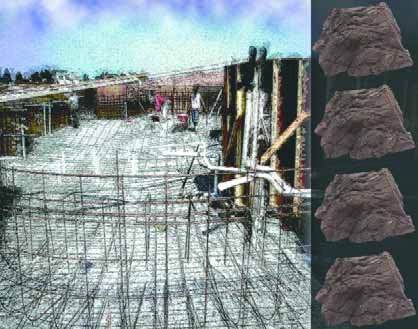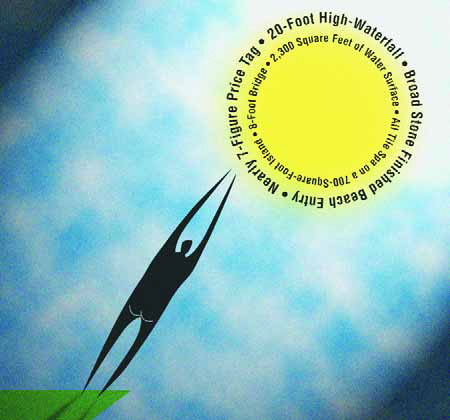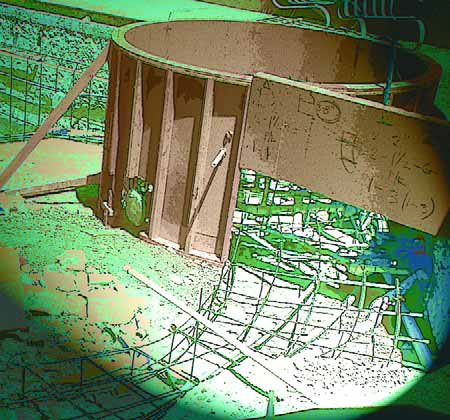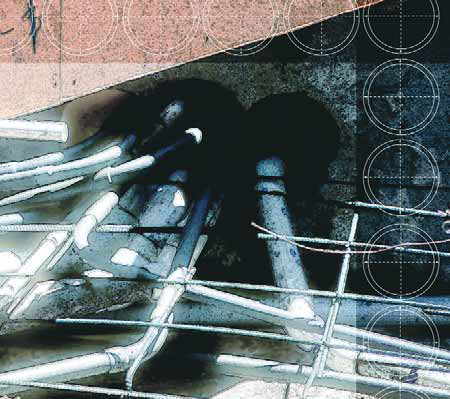Pools & Spas
Designing structures to surround indoor pools offers the watershaper the fundamental challenge of creating an interior space that needs all the functional characteristics of an exterior one. That's so mainly because ordinary residential structures aren't made to enclose anything that even remotely approaches the moisture levels encountered when an indoor pool is surrounded and separated from the open air. This leads to consideration of the air-handing, temperature-control and humidity-related issues covered in another article on this subject (click here), but it almost always leads as well to a need to
Back in November, I described the background of a project on a sprawling estate in the hills near Hanover, Pa. - a spectacular setting for an enormous swimming pool, an island spa, a cascading waterfeature and big expanses of rockwork and stone decking. As was mentioned, our first task was to remove a brand-new system of retaining walls that had been built adjacent to the planned location for the swimming pool. We did so because the wall's large footings reached into a space needed to support a cascade that will appear to tumble into the pool. To ensure
The renovation project I've been discussing for the past couple of issues will be on hold for a few weeks as we await the arrival of a shipment of custom tile from Italy. We'll pick up with that project once work resumes. In the meantime, let's begin coverage of what would have been the next project for "Details" - discussions that will carry us through a good part of the year to come. Everything about this Pennsylvania watershape has been impressive, right from the start. Simply put, it's one of the biggest and most elaborate projects I've ever tackled. As designed, the watershape will
This project is an example of what can happen when you work under ideal conditions. Set in an affluent enclave in Paradise Valley, Ariz., on a spectacular five-acre estate, the home is a model of Old West styling, with the exposed wooden supports and smooth plaster exterior you'd expect to see in a house built in the Arizona Territory in the 19th Century. It's also graced with all the comforts of a modern estate home. The homeowners are repeat clients of mine - and good friends as well. They've owned other properties in the area, and I've had the pleasure of working with them on three other watershaping projects in addition to the one shown here - perhaps our finest collaboration so far. They love art of all sorts, and when it comes to a home's exteriors and especially to its water elements, they view the work as pure creative expression. Typically, their tastes run to the modern, which meant this home was something of a departure for them. It came with beautiful grounds, a winding driveway, gorgeous trees, a man-made brook and pond, all sorts of beautiful views - spacious, yet secluded, an oasis in the midst of crusty, arid, mountainous terrain. The place also had a small, courtyard pool. Typical of work done 20 or 30 years ago, it was something the clients knew they wanted to
It's right up there for longevity in the history of building materials with marble and concrete: The use of glass tile, in fact, dates to the Roman Empire and traces its path through widespread use in Byzantine art in the eastern Mediterranean before finding its way back to a primary role in the art and architecture of Renaissance Italy. From ancient times forward, glass tile has always been associated with beautiful and enduring works of art. Now enhanced by some modern-day manufacturing practices that serve to bring out its incredible gem-like features, the material still holds faith with all those centuries of tradition while reaching
It's not too unusual to replace all of the plumbing, equipment and electrical lines as part of a swimming pool renovation project. It's quite another story, however, when you need to make sure all of it happens without disrupting the deck surrounding the vessel. As mentioned in my last two "Details," that's precisely what we've been asked to do in renovating a 70-year-old pool in the historic Los Feliz neighborhood of Los Angeles. The presence of a beautiful, valuable, imported limestone deck means that we've had to do all of our work from inside
The Arthur D. Kinney Natatorium was designed with a practical mission in mind: From the outset, the facility was intended to provide long-term performance, outstanding aesthetics, ease of operation and minimal maintenance life cycles while enhancing the university's recruiting efforts and fostering individual and team achievement. In this case, however, the "individuals" aren't just star athletes pursuing records and titles. Rather, the natatorium on Bucknell University's Lewisburg, Pa., campus is unique in the sense that the school chose not to segregate varsity athletes from general student/recreational users. Indeed, the facility, part of the university's grand Kenneth G. Langone Athletics & Recreation Center, is designed to bring everyone
It seems so simple: No matter whether it's a residential or commercial project, the design parameters for indoor swimming pools generally call for warm water (typically 82 degrees, or a bit less for a competition pool), air temperature two to four degrees warmer than the water, and a relative humidity in the enclosed space of between 55% and 60%. And it wasn't some committee of pool builders who came up with those figures: The numbers are endorsed and published by the American Society of Heating, Refrigeration & Air-Conditioning Engineers (ASHRAE) and have been accepted as
If the art of watershaping is ultimately about visuals, then creating a situation for yourself in which you're virtually guaranteed to create visual disruptions is something you certainly do not want to do. That's the situation I currently face in the renovation of a pool at a stunning, 1920s-vintage home in the heart of Los Angeles. As I indicated in my last column, it's a remarkably beautiful setting that features a 70-year-old pool that was well designed, expertly installed, well worth keeping - and surrounded by






















